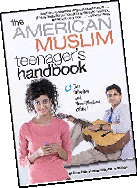 |
Dilara Hafiz, Yasmine Hafiz, Imran Hafiz
Ginee Seo Books/Atheneum/Simon & Schuster
168 pages. $11.99 paperback.
In her local Phoenix bookstore, Yasmine Hafiz noticed many books for Christian teenagers, but none for Muslims. When her brother Imran was labeled by students in his middle school as a member of the Taliban, he longed for an interesting book to explain Islam.
With their mother Dilara, these siblings created the resource they needed. Accessible, pitch-perfect for teens, and even fun, this handbook debunks myths and demystifies facts about Islam, the second-largest religion in the world and “the most misunderstood religion in America.” While addressing young Muslims, it also allows parents to see teen viewpoints and enlightens non-Muslims of all ages. Survey responses from 150 American Muslim high school students add a chorus of voices and opinions.
The opening chapter, “Islam 101,” emphasizes common origins of the world’s three major religions – Christianity, Judaism and Islam – which share 4,000-year-old roots in Abraham, the first believer in one God. In AD 610, revelations of this one God came to the new prophet Muhammad in Arabia, and his writings became the Quran. If American Muslims translate the Arabic name Allah into English as God, the authors advise, misunderstandings with Christians and Jews might fade. Their glossary definition of Allah ends, “Seriously, it just means God.”
Short chapters highlight core beliefs and show how young Muslims approach religious commitments gradually. A step-by-step guide to praying five times a day includes photos of physical positions. Recipes for tasty meals before sunrise and after sunset accompany rules for fasting during Ramadan. More than 99 percent of the teens surveyed anticipated making the once-in-a-lifetime Hajj pilgrimage to Mecca.
After explaining the Muslim stance on issues within American teenage culture – diet, dating, dancing, drinking and drugs – the authors suggest finding ways to blend in while upholding Muslim beliefs. Sometimes there is no room for compromise: “If you’re not ready for marriage, then don’t date.” Girls’ survey responses give reasons for their decisions to wear hijab (the veil) or not.
Surviving in post-9/11 America is the most challenging issue, as young Muslims face others’ conviction that all Muslims are terrorists. This guide has wise counsel: Point out Christianity’s similarities with Islam. Remind fellow Americans that everyone here is an immigrant following the American dream that values freedom of religion, speech and press. “This generation will be stronger and more integrated into the fabric of American society if they rise to the challenge of explaining to others that their faith should not be blamed for the extremist actions of a few men,” the authors say.
Blending adult savvy with teen attitude, information is delivered in digestible pieces leavened with humor. An attractive layout features graphics, photos, boxes and lists. It also offers self-exploration through quizzes such as “Are You Culturally Competent?” This is an illuminating book that parents, teachers, faith leaders, mentors and youth workers will want to share with youth. (800) 223-2336, http://www.simonandschuster.com.

























